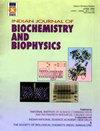Administration of Curcumin, Betanin, and CoQ10 combined with nickel oxide, iron superoxide nanoparticles show preventive effects in breast cancer: Effect on apoptosis pathway and MiR-455 expression
IF 1.5
4区 生物学
Q4 BIOCHEMISTRY & MOLECULAR BIOLOGY
引用次数: 0
Abstract
In the present study, we aimed to evaluate the cytotoxicity and antitumor effect of alone and combined treatment of curcumin, betanin, and coenzyme Q10 (CoQ10) compounds and nickel oxide (NiO) and iron superoxide (Fe2O3) nanoparticles (NPs) on breast cancer cells in vitro and in vivo. The 4T1 breast cancer cells were exposed to different concentrations of Q10, NiO, and Fe2O3 NPs and the inhibitory concentration (IC50) of NPs and compounds and their effect on cell viability In the present study, we aimed to evaluate the cytotoxicity and antitumor effect of alone and combined treatment of curcumin, betanin, and coenzyme Q10 (CoQ10) compounds and nickel oxide (NiO) and iron superoxide (Fe2O3) nanoparticles (NPs) on breast cancer cells in vitro and in vivo. The 4T1 breast cancer cells were exposed to different concentrations of Q10, NiO, and Fe2O3 NPs and the inhibitory concentration (IC50) of NPs and compounds and their effect on cell viability was evaluated by MTT assay. Apoptosis induction in BALB/c mice after treatment with the IC50 concentration of tested compounds was evaluated by flow cytometry. Gene expression was measured using quantitative real-time polymerase chain reaction (qRT-PCR). The IC50 values for Fe2O3 and NiO NPs were found to be 92.42 µg/mL and 21.49 µg/mL, respectively, and were 0.87 µg/mL, 60.14 µg/mL and 83.47 µg/mL for curcumin, betanin, and CoQ10, respectively. Curcumin was more cytotoxic, whereas Fe2O3 showed lower cytotoxicity than the other compounds in the 4T1 line. All treatments significantly exerted anticancer activity against breast tumors. qRT-PCR analysis revealed that treatment with IC50 concentrations of all alone and combined compounds downregulated the expression of Bcl2 and upregulated Bax in breast tumor. The results revealed a significant reduction in TFAM and MiR-455 expression levels. The combination of aforementioned antitumor agents with Fe2O3 and NiO NPs shows a synergistic impact, as apoptosis induction is boosted by a combination of antitumor agents and NPs, and a higher regulatory impact on gene expression occurs compared with monotherapy.姜黄素、甜菜素和辅酶q10联合氧化镍、铁超氧化物纳米颗粒对乳腺癌的预防作用:对凋亡途径和MiR-455表达的影响
在本研究中,我们旨在评估姜黄素、甜菜素和辅酶Q10 (CoQ10)化合物以及氧化镍(NiO)和超氧化铁(Fe2O3)纳米颗粒(NPs)单独和联合治疗对乳腺癌细胞的体外和体内细胞毒性和抗肿瘤作用。研究了姜黄素、甜菜素和辅酶Q10 (CoQ10)化合物以及氧化镍(NiO)和超氧化物铁(Fe2O3)纳米颗粒(NPs)对乳腺癌细胞体外和体内的细胞毒性和抗肿瘤作用,并对NPs及其化合物的抑制浓度(IC50)及其对细胞活力的影响进行了研究。将4T1乳腺癌细胞暴露于不同浓度的Q10、NiO和Fe2O3 NPs中,采用MTT法评估NPs及其化合物的抑制浓度(IC50)及其对细胞活力的影响。用流式细胞术观察化合物IC50浓度对BALB/c小鼠的诱导凋亡作用。采用实时定量聚合酶链反应(qRT-PCR)检测基因表达。Fe2O3和NiO NPs的IC50值分别为92.42µg/mL和21.49µg/mL,姜黄素、甜菜素和辅酶q10的IC50值分别为0.87µg/mL、60.14µg/mL和83.47µg/mL。姜黄素的细胞毒性较强,而Fe2O3的细胞毒性较低。所有治疗方法对乳腺肿瘤均有显著的抗癌作用。qRT-PCR分析显示,IC50浓度的所有单独和联合化合物治疗乳腺癌时,Bcl2表达下调,Bax表达上调。结果显示TFAM和MiR-455表达水平显著降低。上述抗肿瘤药物与Fe2O3和NiO NPs联合使用显示出协同作用,因为抗肿瘤药物和NPs联合使用可促进细胞凋亡诱导,并且与单一治疗相比,对基因表达的调节作用更高。
本文章由计算机程序翻译,如有差异,请以英文原文为准。
求助全文
约1分钟内获得全文
求助全文
来源期刊

Indian journal of biochemistry & biophysics
生物-生化与分子生物学
CiteScore
2.90
自引率
50.00%
发文量
88
审稿时长
3 months
期刊介绍:
Started in 1964, this journal publishes original research articles in the following areas: structure-function relationships of biomolecules; biomolecular recognition, protein-protein and protein-DNA interactions; gene-cloning, genetic engineering, genome analysis, gene targeting, gene expression, vectors, gene therapy; drug targeting, drug design; molecular basis of genetic diseases; conformational studies, computer simulation, novel DNA structures and their biological implications, protein folding; enzymes structure, catalytic mechanisms, regulation; membrane biochemistry, transport, ion channels, signal transduction, cell-cell communication, glycobiology; receptors, antigen-antibody binding, neurochemistry, ageing, apoptosis, cell cycle control; hormones, growth factors; oncogenes, host-virus interactions, viral assembly and structure; intermediary metabolism, molecular basis of disease processes, vitamins, coenzymes, carrier proteins, toxicology; plant and microbial biochemistry; surface forces, micelles and microemulsions, colloids, electrical phenomena, etc. in biological systems. Solicited peer reviewed articles on contemporary Themes and Methods in Biochemistry and Biophysics form an important feature of IJBB.
Review articles on a current topic in the above fields are also considered. They must dwell more on research work done during the last couple of years in the field and authors should integrate their own work with that of others with acumen and authenticity, mere compilation of references by a third party is discouraged. While IJBB strongly promotes innovative novel research works for publication as full length papers, it also considers research data emanating from limited objectives, and extension of ongoing experimental works as ‘Notes’. IJBB follows “Double Blind Review process” where author names, affiliations and other correspondence details are removed to ensure fare evaluation. At the same time, reviewer names are not disclosed to authors.
 求助内容:
求助内容: 应助结果提醒方式:
应助结果提醒方式:


